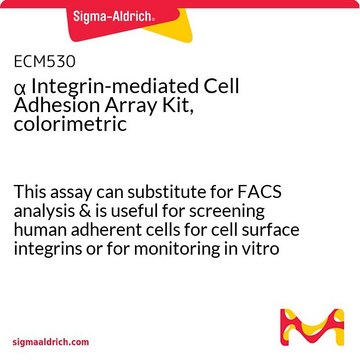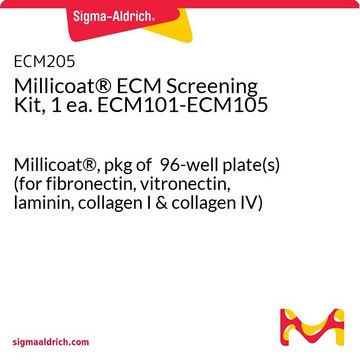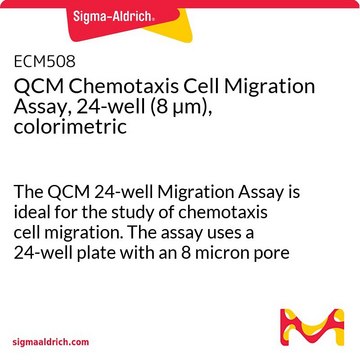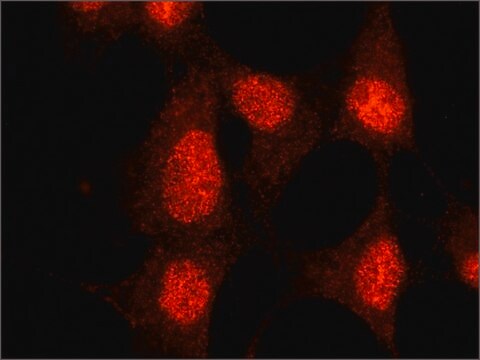ECM540
ECM Cell Adhesion Array Kit, colorimetric
The ECM Cell Adhesion Array kit is useful for assessing specific cell surface integrins, monitoring in vitro cell differentiation, or screening potential cell adhesion promoters/inhibitors.
Synonym(s):
Extracellular matrix array cell adhesion assay
About This Item
Recommended Products
Quality Level
species reactivity
human
manufacturer/tradename
Chemicon®
technique(s)
cell based assay: suitable
detection method
colorimetric
shipped in
wet ice
General description
Cell adhesion plays a major role in cellular communication and regulation, and is of fundamental importance in the development and maintenance of tissues. Scientists are continually examining the adhesion, migration, and invasion of many diverse cell types on various extracellular matrix (ECM) component proteins. The CHEMICON ECM Cell Adhesion Array Kit (Colorimetric) provides an ECM Array microtiter plate with a colorimetric detection format, allowing for large-scale screening and quantitative comparison of multiple samples/cell lines. The kit is designed as a rapid (1-2 hours), cost effective, efficient method for characterization of cell adhesion.
In addition, Chemicon continues to provide numerous migration, invasion, and adhesion products including:
· Alpha Integrin-Mediated Cell Adhesion Array Kit (Colorimetric) (ECM530)
· Beta Integrin-Mediated Cell Adhesion Array Kit (Colorimetric) (ECM531)
· Alpha/Beta Integrin-Mediated Cell Adhesion Array Combo Kit (Colorimetric) (ECM532)
· Alpha Integrin-Mediated Cell Adhesion Array Kit (Fluorimetric) (ECM533)
· Beta Integrin-Mediated Cell Adhesion Array Kit (Fluorimetric) (ECM534)
· Alpha/Beta Integrin-Mediated Cell Adhesion Array Combo Kit (Fluorimetric) (ECM535)
· ECM Cell Adhesion Array Kit (Fluorimetric) (ECM545)
· QCM 8μm 96-well Chemotaxis Cell Migration Assay (ECM510)
· QCM 5μm 96-well Chemotaxis Cell Migration Assay (ECM512)
· QCM 3μm 96-well Chemotaxis Cell Migration Assay (ECM515)
· QCM 96-well Cell Invasion Assay (ECM555)
· QCM 96-well Collagen-Based Cell Invasion Assay (ECM 556)
· 24-well Insert Cell Migration and Invasion assay systems
· CytoMatrix Cell Adhesion strips (ECM protein coated)
· QuantiMatrix ECM protein ELISA kits
Test Principle:
The CHEMICON ECM Cell Adhesion Array kit utilizes a colorimetric detection format, allowing large-scale screening and quantitative comparison of multiple samples. Each kit contains a 96-well, microtiter plate consisting of 12 X 8-well removable strips. Each well within a strip (7 wells total) is pre-coated with a different ECM protein (see table below) along with one BSA-coated well (negative control). Experimental cells are seeded onto the coated substrates, where adherent cells are captured. Subsequently, unbound cells are washed away, and the adherent cells are fixed and stained. After stain extraction, the relative cell attachment is determined using absorbance readings.
Additional information about the ECM components provided in the kit:
Application
Cell Structure
For Research Use Only. Not for use in diagnostic procedures.
Packaging
Components
Cell Stain Solution: (Part No. 90144) One bottle - 20 mL.
Extraction Buffer: (Part No. 90145) One bottle - 20 mL.
Assay Buffer: (Part No. 90601) One bottle - 100 mL.
Storage and Stability
Precautions:
· Cell stain contains minor amounts of crystal violet, a toxic substance, which may cause cancer and heritable genetic damage. Handle with caution. Toxic by inhalation and if swallowed. Irritating to eyes, respiratory system and skin.
· Extraction buffer contains alcohol. Avoid internal consumption.
Legal Information
Disclaimer
Signal Word
Danger
Hazard Statements
Precautionary Statements
Hazard Classifications
Eye Irrit. 2 - Flam. Liq. 2
Storage Class Code
3 - Flammable liquids
Flash Point(F)
53.6 °F
Flash Point(C)
12 °C
Regulatory Listings
Regulatory Listings are mainly provided for chemical products. Only limited information can be provided here for non-chemical products. No entry means none of the components are listed. It is the user’s obligation to ensure the safe and legal use of the product.
PDSCL
Please refer to KIT Component information
PRTR
Please refer to KIT Component information
FSL
Please refer to KIT Component information
ISHL Indicated Name
Please refer to KIT Component information
ISHL Notified Names
Please refer to KIT Component information
Cartagena Act
Please refer to KIT Component information
JAN Code
キットコンポーネントの情報を参照してください
Certificates of Analysis (COA)
Search for Certificates of Analysis (COA) by entering the products Lot/Batch Number. Lot and Batch Numbers can be found on a product’s label following the words ‘Lot’ or ‘Batch’.
Already Own This Product?
Find documentation for the products that you have recently purchased in the Document Library.
Customers Also Viewed
Our team of scientists has experience in all areas of research including Life Science, Material Science, Chemical Synthesis, Chromatography, Analytical and many others.
Contact Technical Service










